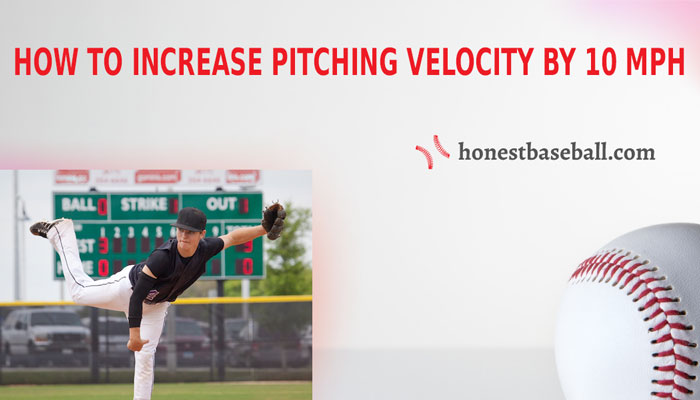Last Updated on October 18, 2023
How to increase the pitching velocity by 10 mph? What difference does this 10 mph matter? Baseball batting is all about reaction time. And this extra bit of mph creates a huge difference in terms of batting reaction time.
Modern players are approaching new techniques to increase their speed and velocity, and do you know what it has done to the batters?
In 1998 the average strikeout rate was 16.9%. After 12 years, in 2010, the average strikeout increased to 17.5%, and after another decade, in 2022, the rate was 22!
What is the reason behind the high rate of strike out? Many experts bring out many reasons, but the most established reason is these days, pitchers are fast. Each team has at least five or six players who can ball at a speed of 95mph. Legendary Billy Wagner used to through at 96mph!
Look at the below graph of how the average velocity has increased over the years.

Here is another chart that displays the percentage of average fastball velocity over 95mph.

So, the baseball pitchers are doing a great job in terms of throwing velocity. And, if you are into baseball like me and if you are a pitcher, you must want to achieve an efficient pitching delivery to become a high-velocity pitcher.
The Average speed for Different Age groups.
I have dedicated this article to increased pitching velocity. But before that, you must know the limit. Too much effort will bring a long-term injury, and you can find yourself in serious trouble.
Whoever is reading this article, I don’t know your age, but you should know the ball velocity you can achieve.

Here is the average speed of different age groups:
Professional
Fastball: 80 – 95 mph
Knuckleball: 55 – 70 mph
Changeup: 70 – 85 mph
Around 10 Years
Fastball: 40 – 50 mph
Knuckleball: 25 – 35 mph
Changeup: 30 – 40 mph
Around 13-14 Years
Fastball: 55 – 75 mph
Knuckleball: 30 – 50 mph
Changeup: 45 – 65 mph
Around 11-12 Years
Fastball: 50 – 60 mph
Knuckleball: 30 – 40 mph
Changeup: 40 – 50 mph
High School
Fastball: 75 – 85 mph
Knuckleball: 50 – 60 mph
Changeup: 65 – 75 mph
If you are in high school you should be interested in this article Can You Run Over The Catcher In High School Baseball?
Insights into Increasing Pitching Velocity Major League Baseball
In the first section, I have discussed baseball pitchers improving their speeds over time. Advanced technology was introduced in 2007 for the first to track the ball’s speed reliably.
If you also want to check your pitching speed with radar gun, you can read our 7 best Baseball radar gun to check and improve pitching speed.
The chart below shows 8 major league pitchers had an average of 95 mph in 2007; after just 7 years, the number jumped to 15. Do you know the number in 2014? 20!.
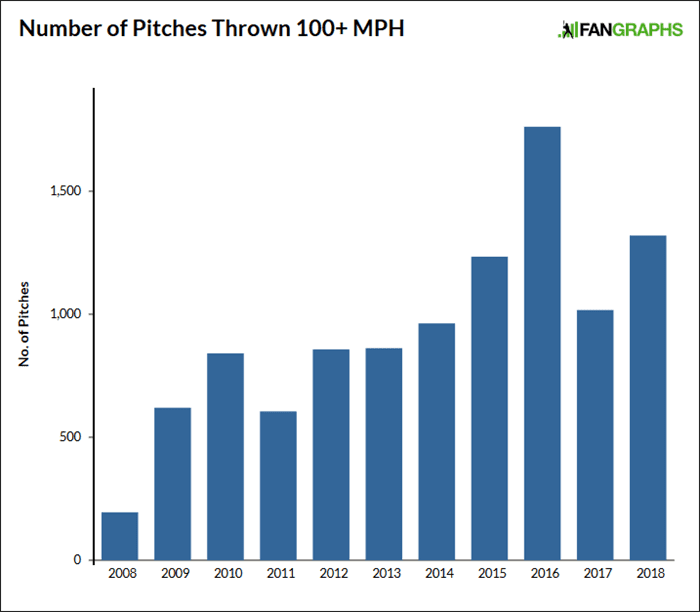
Let me inform you of another piece of information. In 2007 over 95 mph relief pitchers were 27. And after seven years, the number increased to 54 – a 100% increment.
So, it’s evident that the pitchers are throwing faster than the previous times.
The Average Fastball Velocity of MLB Pitchers Has Increased
I collected data from Fangraphs.com. If we see the pitching velocity from another angle, the average four-seam fastball MLB players were 90.9 mph.
In 2014, the number jumped to 92.6 mph.
Every sport is now more digitized than previously. Modern-day pitchers are not throwing the ball faster than before, taking advantage of the analytical age.
American sports medicine Academy and every mechanic in every baseball team are trying to improve pitchers’ velocity, durability, and efficiency.
When it comes to strength, pitchers are becoming stronger. Modern-day pitchers are the best athletes on the field these days. In modern days baseball teams have a special process to teach the pitchers to throw better deliveries at a high velocity from a younger age.
With modern-day technologies, pitchers can fix their velocity targets, measure their results, and practice to meet them.
How to Increase Pitching Velocity by 10 mph
If you have followed the article so far, I hope now you are convinced that the pitcher’s throwing velocity has been increasing day by day. And I have provided sufficient data on how they are gradually increasing year after year in major league baseball.
As a result, you can guess players and teams both are more serious about pitching velocity these days. And there are some “Do” and “Don’t Do” if you want to increase pitching velocity by 10 mph.
This section will elaborate on that to increase your velocity by ten mph.
1. Leave behind the conventional process.
If you are a baseball pitcher, you must have heard, land soft, slow controlled stride, lift up, down” and out, “Stay back, reach out.” “Land closed and then rotate your hips.” “Slow down,” “Don’t push off.” You must have heard these shouts from your coaching staff a thousand times.
But let me tell the truth, this conventional wisdom is of no use these days. Most coaches just heard this information from their coaches, and they are just passing on the information. Most of that wisdom was from the era when the computer was not invented.
You can say, weren’t those previous pitchers fast? Yes, many of them were fast, many of them were very fast, but the average number increased dramatically after the invention of the computer.
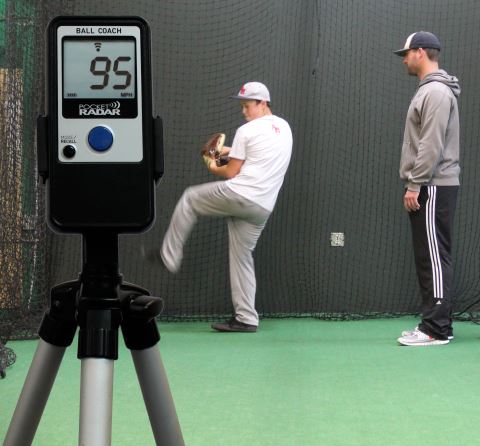
The high-speed camera, video, and motion analysis technology have completely changed the understanding of the high-velocity pitcher. If the coach does not know the technology outside of the field, then there is a high chance that they are using old-days wisdom.
That’s why professional and young pitchers always follow the latest scientific technology to learn the real science that can enhance the velocity of their ball.
2. Add some weight to the Body
When I was young, I was skinny, and my siblings used to make jokes about me. They used to tell me I could be used as a skeleton in a Biology class. Though today’s health experts say that getting overweight is always bad, you must increase your body mass if you want to increase your body weight.
Eating 500 extra calories each day and getting a healthy body weight will help a pitcher to improve velocity significantly.
However, getting mass should have a slow process. An unhealthy mass can affect your health resulting in various complications in the future. What is the standard for getting additional weight?
Gaining 1/2 to 1 pound per week. It is ideal, according to two major medical colleges.
So, doing the math can take 6-8 months to gain 10-15 pounds.
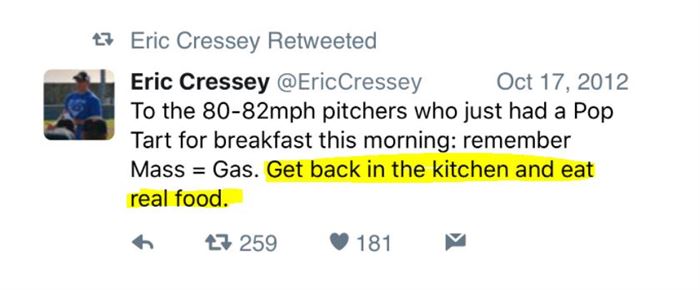
3. Speed up the time from the stride foot contact and the highest external rotation of the throwing shoulder.
The best-throwing pitchers in any level of baseball go from SFC to MER (Stride foot contact to maximum external rotation in .244 seconds. Source Journal of (shoulder and elbow surgery)
4. Bring the Glove into the play
With a good excellent glove-arm action, you can earn many benefits. For example, it can provide good trunk rotation, good shoulder alignment, and many more that can increase arm velocity.
5. Balance Point
I always try to watch the actions of the pitchers closely. I used to watch Justin Verlander’s pitch closely. If you also notice, he eliminates pause or stops at the time of the peak of his leg lift.

A study in 2004 revealed this. The result of that study was extraordinary. Baseball pitchers using a balance point had more head movement resulting in lower velocity. Besides, that affected the accuracy also.
Here is what a balance point can do:
- Reduces momentum, resulting in a decrease in quickness and velocity.
- Creates an un-athletic posture
- Poor timing affects the accuracy.
- Raise lead knee to a minimum of 60% (but not more than 70%) during leg kick.
The lead knee provides momentum to the pitchers. If the lead knee isn’t raised enough, the pitcher will not get good momentum. Talking of “enough,” the knee height should not be less than 60 degrees.
On the other hand, if the lead knee rises too high (more than 70 degrees), the momentum down can be started too late.
6. Enhance the foot strike and knee flexion
There is a researcher’s thumb rule for this factor; the more the front knee is bent at SFC or stride foot contract, the higher a pitcher’s velocity. The average SFC is 48 degrees for elite pitchers.
7. Get more time by keeping the head behind the lead hip.
This method also produces less stress on the shoulder.
8. At Stride foot contact increase Elbow flexion
It is normal physics. By bending your throwing elbow more at foot strike, you will achieve additional velocity. For the hardest throwers, the bending is almost 90 degrees.
9. Don’t rush
Don’t rush to your delivery. As a result of rush, the arm position stays too low at when your stride foot touches the ground affecting the arm acceleration.
Consequently, the low arms position reduces the pitch velocity.
10. Increase shoulder external rotation at maximum
You can achieve more velocity from how far your throwing arm rotated back because of the increased static energy.
Strong pitchers have a maximum external rotation of 160-180 degrees.
11. Increase elbow flexion velocity
The throwing arm must have good elbow flexion once that is relaxed, cocked, and ready,
12. Increase torso and pelvis rotation velocity
Here is the formula Extension + Rotation = Power. That’s why pitchers need to be very quick with movements related to pitching. Do not push your back foot too much, as that will help the ball go upward. So, it’s important for the pitchers to be quick with all movements. The front foot landing, trunk rotation, and throwing all should be fast.
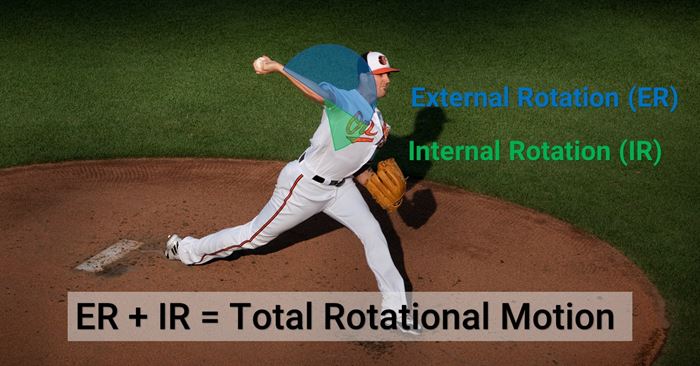
Though I am not an MLB pitcher, I managed to up my speed from the 80s to 90s. The reason behind this is that I tried to read all the resources I could get regarding this matter. That was my only obsession.
As far as I know, it was Coach Bill Thurston from Amherst College who was the first man to say that the velocity depends on the rotational force of the entire body, not any sole part. He believed it was a result of the entire process rather than any specific element.
Bul Thurston identified that a pitcher’s velocity depends on how quickly a pitcher can release the energy from their legs into the rotational forces of the torso that bring the arm through to release the ball.
Moreover, Gambetta Arnel Aguinaldo, from Children’s Hospital, San Diego, California, proposed that larger body segments create most of the velocity while throwing.
Several institutes have other experiments, and Biomechanics provided new information to increase the pitching velocity by 10 mph.
13. Increase knee flexion at ball release.
Hard pitchers tend to bend their ball to 60 degrees or more at the time of release. As a result, the high-velocity pitcher’s knees bent from 48 degrees to 60 degrees when they released the ball.
That is called “bracing up” against a firm front leg in baseball.
Studies show that when the front leg touches the pitch, that absorbs twice the body weight. So, those who can throw the ball at more velocity have more bracing up than the others.

So, the formula is, “a Stronger front leg is the key to harder throw.”
Bruce MacWilliams experimented with the GRF and found that leg drive is significant for throwing velocity. Consequently, they established a link between the pitcher’s arm velocity and the leg motion.
However, the forward motion is the only important factor. Besides, the lead leg blocks the forward motion is also an essential factor.
There were more demonstrations about the front leg—for example, Elliott et al. (1988).
14. Enhance forward trunk tilt while releasing the ball.
All the flexing happens to the hips instead of the back. At the release point, the back should stay straight.
15. Increase stride length
While striding, aiming for 90% of the pitcher’s height, targeting 95-100% of his height. This combination provides plenty of momentum to carry him into a long stride length which should be 83% of his height (Top pitchers can reach 95-100%)
This combination provides a good boost in speed. If you measure from the front edge of the rubber to the toe of the stride foot, the stride’s length MUST be close to the height of the pitcher.
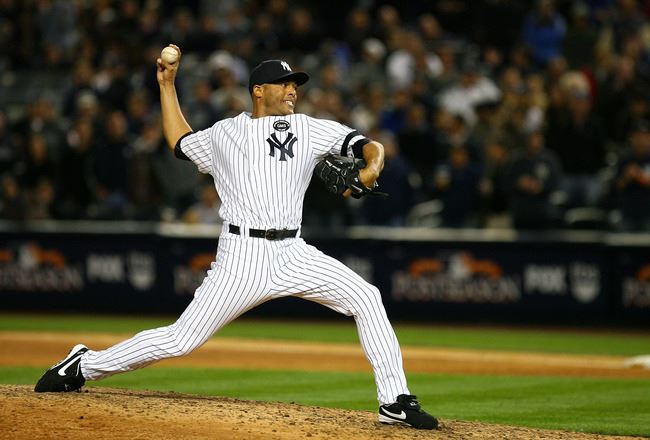
Aim for the longest possible stride where you can still get your shoulders and head the lead leg at the realizing point.
16. The finishing should be “Flat Back” Position
Acceleration‐Demonstrating trunk inclination, and humeral adduction between 32 degrees and 55 degrees before ball release.
17. Four-Seam Grip is Circular.
Four seam grip gives you the best control over the ball. Hence it is very crucial to add some extra velocity while you throw.
Don’t forget; you need to apply force to generate velocity from the baseball.
18. The wrist plays a vital role
In the pitching motion, the wrist is the most vital lever. In fact, there is very interesting research also.
Norihisa Fujii from the University of Tsukuba conducted a study in 2002 and found that.
The wrist is a very important lever in pitching motion. That’s why many coaches added wrist flicks in the warm-up session. In fact, Norihisa Fujii from the strength and wrist flexion are two major factors to increase the velocity.
According to the Lexington Clinic, the wrist is responsible for 10% of the force applied to the baseball while the pitcher makes a delivery.
18. The Forearm is also important
We are talking about how to increase the pitching velocity by 10 mph, and achieving this, the forearm is also vital. Will Carrol, a famous baseball writer, also discussed this topic in one of his famous books.
So, what should you do for your forearm? You should develop your forearm muscle for that extra velocity.
19. Achieve more ground reaction by building leg strength
For efficient weight shift, leg strength is all-important. The leg is the lower half initiating movement down the hill and imports energy in the process.
And the leg strength converts the linear momentum into rotational momentum. More energy will transfer when pitchers apply the breaks more abruptly. This has two benefits – more velocity on the delivery and reduced wear and tear on the arm.
Remember, baseball is a game of stamina. And strong leg will help you to get more stamina which will allow you to pitch a high-velocity ball.
I used to have less strong legs, and that affected my pitching. But after working on my legs, I found that I gained enough stamina to a ball over 90 mph consistently for a longer period of time.
20. Cuff Strength Building
It is the key contributor to the overhead throw. Let me tell you some very crucial data on this topic. 21% of the force that the ball gains comes from the shoulder. This investigation was done by Lexington Clinic.
There is another research to back this theory. And that was practical research conducted by a university in 2001.
21. Don’t train for a strong arm but for a fast arm also
I have discussed the strong arm earlier in this article, but the fast arm is as important as the strong arm. So, don’t train for the strong arm. Velocity needs momentum, which is the result of force and acceleration.
So, without acceleration, strength is not going to give you the highest momentum. So, train for the fast arm also in the training session.
21. Do Medicine Ball Exercise
Yes, this is an excellent exercise to add some velocity to your ball. You can do both rotational energy and linear energy with medicine balls. This is a MUST DO exercise for all pitchers who want to increase their velocity.
22. Become More aggressive
I have talked about the tactical aspects of how to increase pitching velocity. But I didn’t talk about the mindset. But that is as crucial as tactical practices.
To pitch faster, you must have a mindset that “I want to pitch fast.” This is called “Intent.” So, be focused, stay focused, and DO NOT loos your intent. You want to pitch fast, and you will achieve that at any cost. That should be the intent.
I was not a major league player. My speed was in the 80s. But I achieved the 90-plus mark because I had the intent. I had many drawbacks, but I overcame all of those because I had only one goal in my baseball career: to ball as fast as I could.
You can take these professional drilling supports.
There is an institute called the top velocity program. You can admit into their drilling programs to add 5-10 mph additional velocity to your pitch. Here I am mentioning some of the drills you can take.

Honestly, I have no connection with them and not doing any affiliate for them. It’s just they are a very good institute and run by highly expert people. I love their process, and that’s the only reason I am referring to them. Here are some of the drills you can take part into:
- 3X Med Ball Chest Up Series
- 3X Med Ball Separation Series
- 3X Med Ball Lateral Series
- 3X Chest Up Target Throws Series
- 3X Separation Target Throws Series
- The 3X Sled
- 3X Assistance Drills
- 3X Drive Drills
- Force Vector Throws (Level 3)
- 3X Power Throws
The names could be alien to you. But I strongly recommend you to visit their website. Learn from them. Learn the procedure they follow and their success rate. I hope that will convince you to take part in their programs.
The programs could be a little expensive for you. But believe me, if you want to add increased pitching velocity by 5 to 10 mph, the money you will spend is totally worth it. So, if you are serious about your baseball, at least visit their institute once.
You Might Also Need to Know
What additional exercises Can I do to increase my pitching velocity?
Here are some exercises you can perform regularly:
Weightlifting
It’s a very handy exercise. Try to lift 50 to 60% more weight you can lift. It will be more helpful if you can also mix this exercise with stretches.
Jump Roping
It helps to increase the rotator cuff’s external rotation strength.
Bench presses, wrist curls, triceps pulldowns, and pushups
These exercises help with upper body strength training, such as the chest, forearm muscles, and triceps. If you have followed my article these are key body parts to increase your pitching velocity.
How fast is the average MLB fastball in 2021?
The average fastball in 2021 MLB was over 95 mph.
Who bowled the fastest delivery in the MLB 2021?
deGrom, Jacob holds the record for the fastest pitching velocity of 2021. The fastest delivery he bowled was 99.2 mph.
What is the fastest pitch ever in MLB?
The fastest recorded pitch ever in the MLB is 105.8 mph. Chapman made this history on 24th September 2010. Interestingly Capman did nearly the same speed a few years later. He threw a 105.1 mph lightning fastball against Baltimore Orioles.
Final Words
how to increase pitching velocity by 10 mph? that was your question. Why?
5-10 mph additional velocity creates a huge difference in baseball. That’s why these days, every team emphasizes this extra speed to get more strikeouts. And statistics show that this is working.
If you are a baseball pitcher and want to play at the top level, you must have that extra speed. And it never comes so easy. You need years after years of exercise and ‘intent.’
I hope now you have a clear idea of how to increase pitching velocity by 10 mph. It’s a very tough task to do and depends on many factors. I hope you will be able to follow the procedure patiently—best of luck to you.
Follow the instructions and tell yourself, “You can do it.”

Hi Athletes, welcome to Honest Baseball. My name is Becky Cahill, and I live in Georgia (USA). I have played or coached softball most of my life and love the game. I attended Auburn University in the Southeastern Conference on a softball scholarship and started coaching right after graduating. I have coached at the college, high school, and little league levels. As a coach, I have worked with beginners all the way up to All-Americans. I can’t wait to share my passion and knowledge of softball with you. Let’s learn more about the game together!
